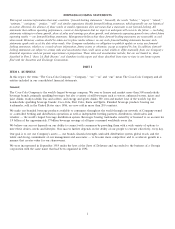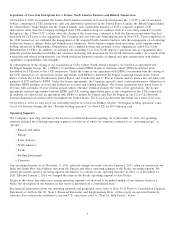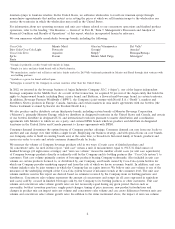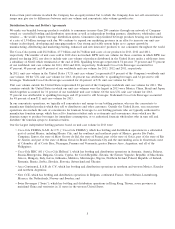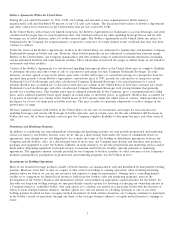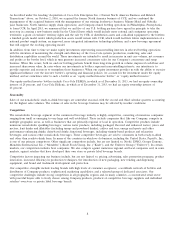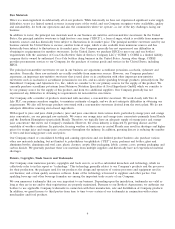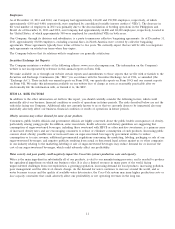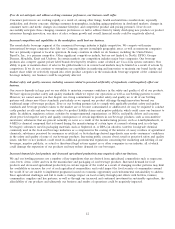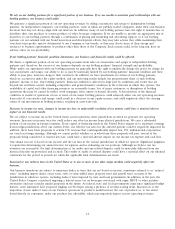Coca Cola 2013 Annual Report Download - page 6
Download and view the complete annual report
Please find page 6 of the 2013 Coca Cola annual report below. You can navigate through the pages in the report by either clicking on the pages listed below, or by using the keyword search tool below to find specific information within the annual report.
fountain syrups to fountain retailers. In the United States, we authorize wholesalers to resell our fountain syrups through
nonexclusive appointments that neither restrict us in setting the prices at which we sell fountain syrups to the wholesalers nor
restrict the territories in which the wholesalers may resell in the United States.
For information about net operating revenues and unit case volume related to our concentrate operations and finished product
operations, refer to the heading ‘‘Our Business — General’’ in Part II, ‘‘Item 7. Management’s Discussion and Analysis of
Financial Condition and Results of Operations’’ of this report, which is incorporated herein by reference.
We own numerous valuable nonalcoholic beverage brands, including the following:
Coca-Cola Minute Maid Glac´
eau Vitaminwater Del Valle3
Diet Coke/Coca-Cola Light Powerade Georgia1Ayataka4
Coca-Cola Zero Aquarius Simply2Bonaqua/Bonaqa
Sprite Dasani Minute Maid Pulpy Schweppes5
Fanta
1Georgia is primarily a coffee brand sold mainly in Japan.
2Simply is a juice and juice drink brand sold in North America.
3We manufacture, market and sell juices and juice drinks under the Del Valle trademark primarily in Mexico and Brazil through joint ventures with
our bottling partners.
4Ayataka is a green tea brand sold in Japan.
5Schweppes is owned by the Company in certain countries other than the United States.
In 2012, we invested in the beverage business of Aujan Industries Company J.S.C. (‘‘Aujan’’), one of the largest independent
beverage companies in the Middle East. As a result of this transaction, we acquired 50 percent of the Aujan entity that holds the
rights to Aujan-owned brands, including Rani, a juice brand, and Barbican, a flavored malt beverage brand, in certain territories.
In addition, Beverage Partners Worldwide (‘‘BPW’’), the Company’s joint venture with Nestl´
e S.A. (‘‘Nestl´
e’’), markets and
distributes Nestea products in Europe, Canada, Australia and certain markets in Asia under agreements with our bottlers (the
Nestea trademark is owned by Soci´
et´
e des Produits Nestl´
e S.A.).
We also produce and/or distribute certain third-party brands, including certain brands of Monster Beverage Corporation
(‘‘Monster’’), primarily Monster Energy, which we distribute in designated territories in the United States and Canada, and certain
of our bottlers distribute in designated U.S. and international territories pursuant to master distribution and coordination
agreements with Monster to which we are a party; and certain DPSG brands which we produce and distribute in designated
territories in the United States and Canada pursuant to license agreements with DPSG.
Consumer demand determines the optimal menu of Company product offerings. Consumer demand can vary from one locale to
another and can change over time within a single locale. Employing our business strategy, and with special focus on core brands,
our Company seeks to build its existing brands and, at the same time, to broaden its historical family of brands, products and
services in order to create and satisfy consumer demand locale by locale.
We measure the volume of Company beverage products sold in two ways: (1) unit cases of finished products and
(2) concentrate sales. As used in this report, ‘‘unit case’’ means a unit of measurement equal to 192 U.S. fluid ounces of
finished beverage (24 eight-ounce servings); and ‘‘unit case volume’’ means the number of unit cases (or unit case equivalents)
of Company beverage products directly or indirectly sold by the Company and its bottling partners (the ‘‘Coca-Cola system’’) to
customers. Unit case volume primarily consists of beverage products bearing Company trademarks. Also included in unit case
volume are certain products licensed to, or distributed by, our Company, and brands owned by Coca-Cola system bottlers for
which our Company provides marketing support and from the sale of which we derive economic benefit. In addition, unit case
volume includes sales by joint ventures in which the Company has an equity interest. We believe unit case volume is one of the
measures of the underlying strength of the Coca-Cola system because it measures trends at the consumer level. The unit case
volume numbers used in this report are derived based on estimates received by the Company from its bottling partners and
distributors. Concentrate sales volume represents the amount of concentrates and syrups (in all cases expressed in equivalent
unit cases) sold by, or used in finished beverages sold by, the Company to its bottling partners or other customers. Unit case
volume and concentrate sales volume growth rates are not necessarily equal during any given period. Factors such as
seasonality, bottlers’ inventory practices, supply point changes, timing of price increases, new product introductions and
changes in product mix can impact unit case volume and concentrate sales volume and can create differences between unit case
volume and concentrate sales volume growth rates. In addition to the items mentioned above, the impact of unit case volume
4



